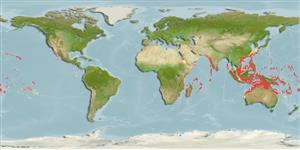>
Anguilliformes (Eels and morays) >
Ophichthidae (Snake eels) > Ophichthinae
Etymology: Apterichtus: From the Greek απτερόν (apteron), without fins, and ίχθύς (ichtus, more correctly written ichthys; masculine), fish..
More on author: Weber.
Environment: milieu / climate zone / depth range / distribution range
Écologie
marin démersal; profondeur 1 - 120 m (Ref. 86942). Tropical
Indo-Pacific: East Africa to the Marshall Islands (Ref. 2334); reported from the Hawaiian Islands (Ref. 58302) and Marqueses (Ref. 101270).
Taille / Poids / Âge
Maturity: Lm ? range ? - ? cm
Max length : 40.0 cm TL mâle / non sexé; (Ref. 2334)
Description synthétique
Clés d'identification | Morphologie | Morphométrie
Épines dorsales (Total) : 0; Rayons mous dorsaux (Total) : 0; Épines anales: 0; Rayons mous anaux: 0. Light tan with fine brown spots on head and throat (Ref. 3972). Lacks fins altogether (Ref. 1602).
Benthic (Ref. 58302). Forms congregations in confined sandy areas of sandy bottoms (Ref. 30874) where it buries itself using its pointed snout or its bony, sharp tail. May feed on small fishes, crabs, and prawns (Ref. 30874).
Life cycle and mating behavior
Maturities | Reproduction | Spawnings | Egg(s) | Fecundities | Larves
Randall, J.E., G.R. Allen and R.C. Steene, 1990. Fishes of the Great Barrier Reef and Coral Sea. University of Hawaii Press, Honolulu, Hawaii. 506 p. (Ref. 2334)
Statut dans la liste rouge de l'IUCN (Ref. 130435)
Menace pour l'homme
Harmless
Utilisations par l'homme
Outils
Articles particuliers
Télécharger en XML
Sources Internet
Estimates based on models
Preferred temperature (Ref.
123201): 24.3 - 28.8, mean 27.3 °C (based on 624 cells).
Phylogenetic diversity index (Ref.
82804): PD
50 = 0.5000 [Uniqueness, from 0.5 = low to 2.0 = high].
Bayesian length-weight: a=0.00089 (0.00039 - 0.00204), b=3.00 (2.80 - 3.20), in cm total length, based on LWR estimates for this (Sub)family-body shape (Ref.
93245).
Niveau trophique (Ref.
69278): 3.9 ±0.67 se; based on food items.
Résilience (Ref.
120179): Haut, temps minimum de doublement de population inférieur à 15 mois (Preliminary K or Fecundity.).
Fishing Vulnerability (Ref.
59153): Low to moderate vulnerability (30 of 100).
